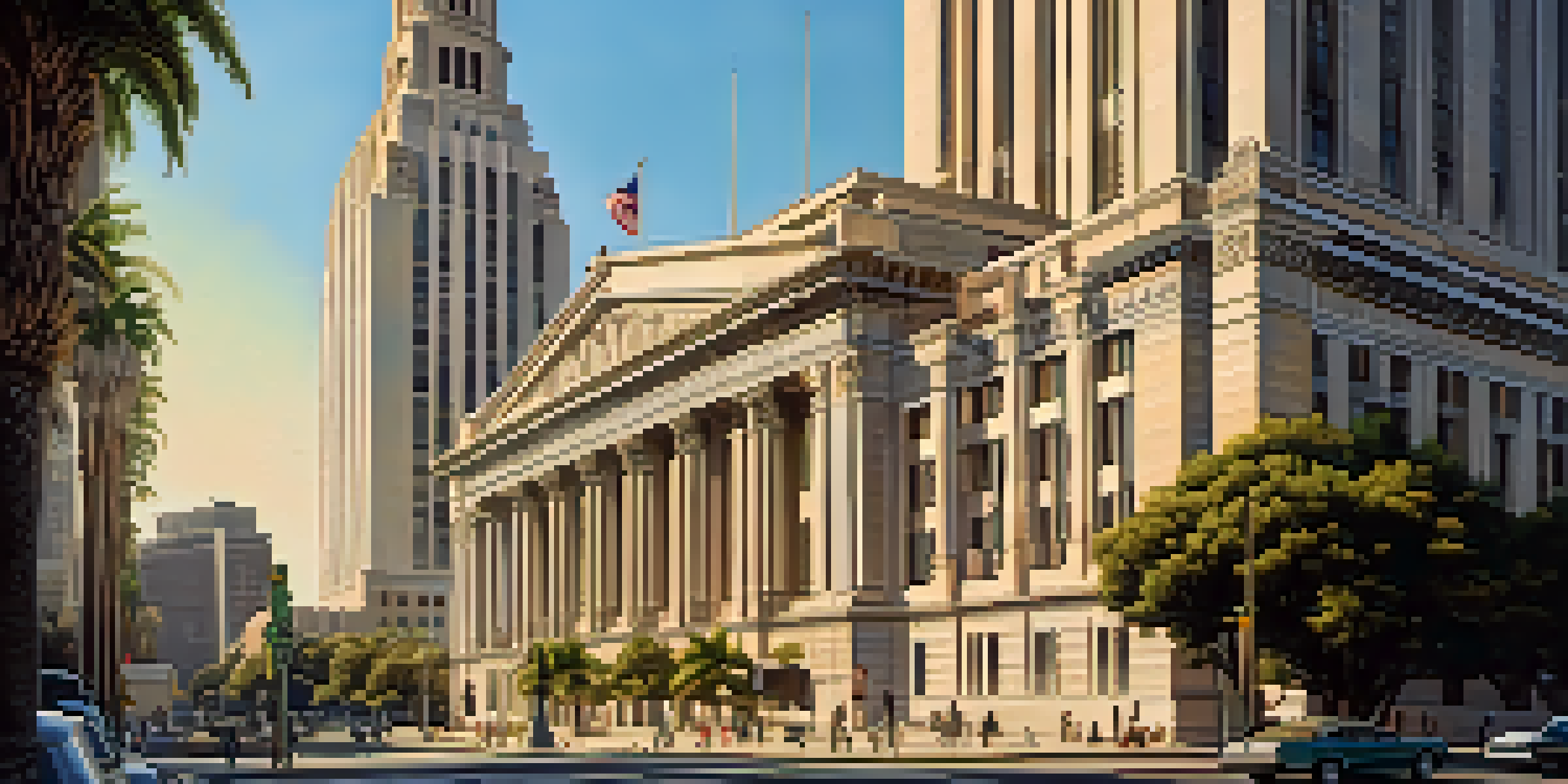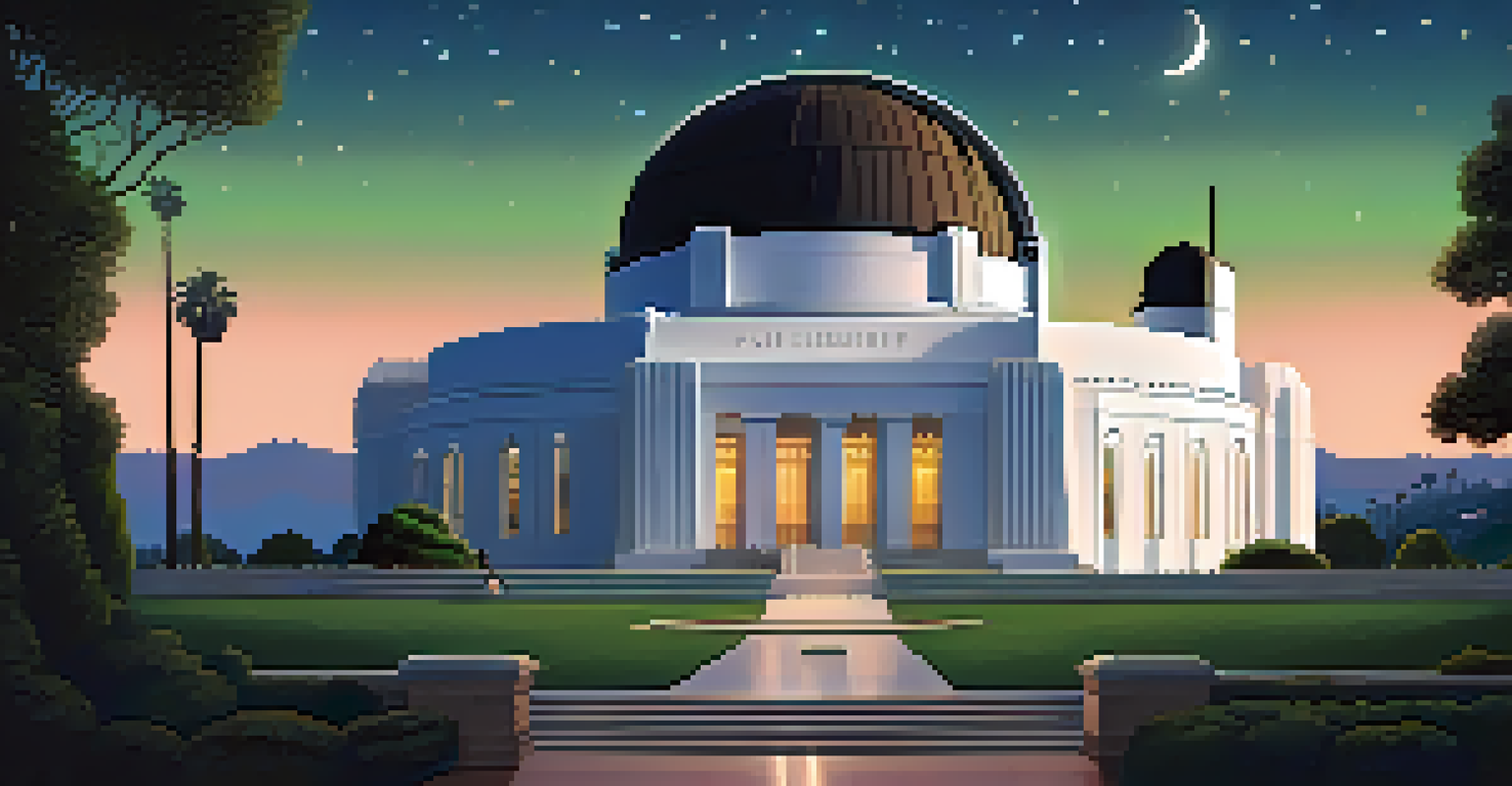Exploring the Art Deco Marvels of Los Angeles Architecture

Introduction to Art Deco: A Brief Overview
Art Deco is a design style that emerged in the 1920s and 1930s, characterized by its bold geometric shapes and vibrant colors. In Los Angeles, this architectural movement left a lasting impression on the city's skyline, blending modernity with artistic flair. Understanding Art Deco helps us appreciate how it reflects the culture and aesthetics of its time.
Architecture is the art of how to waste space.
The style is not just about buildings; it embodies a spirit of innovation and luxury, often seen in everything from cinema palaces to residential homes. In LA, where the film industry flourished, Art Deco mirrored the glamour and excitement of Hollywood's golden age. Exploring these structures gives us a glimpse into a bygone era that still captivates today.
As we delve deeper into the Art Deco marvels of Los Angeles, we'll discover not only the architectural features but also the stories behind these iconic buildings. From their design to their cultural impact, each site has a unique narrative that connects us to the past, enriching our understanding of the city's history.
The Los Angeles City Hall: A Stunning Landmark
Completed in 1928, the Los Angeles City Hall stands as a beacon of Art Deco architecture. Its distinctive tower, reaching 454 feet, was once the tallest building in the city and showcases the style's characteristic vertical lines and intricate details. The building's design reflects the optimism of the era, symbolizing the growth and aspirations of Los Angeles.

Visitors can admire its impressive façade adorned with decorative motifs, such as eagles and sunbursts, that speak to the Art Deco aesthetic. Inside, the grandeur continues with marble floors and ornate ceilings, making it a must-see for architecture enthusiasts. The City Hall isn’t just a functional space; it’s a celebration of artistic vision.
Art Deco Shapes LA's Identity
The Art Deco movement has significantly influenced Los Angeles' architectural landscape, reflecting the cultural aspirations of its time.
Moreover, the City Hall's position in the heart of downtown Los Angeles makes it easily accessible to those wanting to explore the surrounding area. Its historical significance and stunning design make it a prime example of how Art Deco has shaped the city's identity over the decades.
The Iconic Griffith Park Observatory
The Griffith Park Observatory, designed in 1935, is another remarkable example of Art Deco architecture in Los Angeles. Nestled in the hills overlooking the city, its striking white structure features a blend of Art Deco and Streamline Moderne styles. This combination not only enhances its visual appeal but also makes it a beloved cultural landmark.
Good buildings come from good people, and all problems are solved by good design.
The observatory offers stunning views of the Los Angeles skyline and is an educational hub for astronomy enthusiasts. Inside, visitors can explore interactive exhibits and gaze at the stars through its historic telescopes. The observatory's design and function embody the spirit of discovery and exploration prevalent during the Art Deco period.
Additionally, the observatory has appeared in numerous films, further solidifying its status in pop culture. It's a perfect example of how Art Deco architecture can intertwine with community engagement and educational outreach, making it a cherished spot for both locals and tourists alike.
Art Deco Theaters: A Cinematic Experience
Los Angeles is home to several iconic Art Deco theaters that reflect the city's rich cinematic history. The El Capitan Theatre, for instance, opened in 1926 and showcases a gorgeous façade featuring intricate tile work and vibrant colors. This venue has hosted countless film premieres, making it a cornerstone of Hollywood's entertainment culture.
Another notable theater is the Wiltern, which boasts a stunning blue-green exterior and an equally impressive interior adorned with murals and ornate fixtures. These theaters not only served as places for viewing films but also as social hubs where glamour and entertainment converged. They exemplify the Art Deco movement's fascination with the entertainment industry.
Preservation Efforts are Essential
Maintaining and restoring Art Deco structures is crucial for honoring the city's historical and cultural heritage amidst modernization.
Visiting these theaters gives a sense of nostalgia, allowing us to step back in time and experience the grandeur of the early 20th century. It's easy to imagine the excitement of audiences dressed in their finest attire, ready to be transported into the magical world of cinema.
The Historic Los Angeles Public Library
The Los Angeles Public Library, completed in 1926, is a stunning Art Deco masterpiece that deserves recognition. Its unique design features a combination of Mediterranean Revival and Art Deco styles, creating a visually striking structure. The building's iconic tower, adorned with a golden pyramid, stands as a symbol of knowledge and enlightenment.
Inside the library, visitors are greeted with beautiful murals and intricate details that reflect the city's cultural heritage. The grand reading room, with its high ceilings and natural light, provides an inviting space for learning and exploration. The library not only serves as a repository of books but also as a community center that hosts various events and programs.
Exploring the library connects us to the city’s commitment to education and culture, showcasing how Art Deco architecture can harmoniously blend form and function. It reminds us that these buildings are not merely structures; they represent ideals and aspirations that continue to inspire future generations.
The Unique Challenge of Preserving Art Deco
Preserving Art Deco architecture in Los Angeles presents unique challenges, as many of these structures face the threat of modernization. Urban development often prioritizes new constructions, which can overshadow these historical gems. However, various organizations and local communities are dedicated to maintaining and restoring these architectural treasures.
The preservation efforts involve not only physical restoration but also raising awareness about the cultural significance of these buildings. By highlighting their historical value, advocates strive to ensure that future generations can appreciate the beauty and craftsmanship of Art Deco. Community events and educational programs play a crucial role in fostering this appreciation.
Walking Tours Enhance Appreciation
Guided walking tours offer an engaging way to explore Art Deco architecture, providing insights into their historical context and significance.
Ultimately, preserving Art Deco architecture is an investment in the city's identity and heritage. It allows us to celebrate our past while shaping a future that respects and honors the artistry that has come before us, ensuring that these marvels remain a part of Los Angeles for years to come.
Exploring Art Deco: Walking Tours in LA
One of the best ways to experience the Art Deco treasures of Los Angeles is through guided walking tours. These tours provide a unique opportunity to learn about the history and architectural details of each building while enjoying the vibrant atmosphere of the city. Knowledgeable guides share fascinating stories that breathe life into the structures, making the past feel immediate and relevant.
Walking tours often include stops at various iconic sites, such as the Bullocks Wilshire and the Mayan Theater, allowing participants to appreciate the diversity of Art Deco design. The experience is not just about seeing the buildings; it's about understanding the context in which they were built and their impact on the community. Each step reveals layers of history waiting to be uncovered.

Whether you are an architecture buff or just looking for a fun way to explore, these tours offer an engaging and memorable experience. They connect us to the city’s artistic legacy while encouraging us to appreciate the craftsmanship and creativity that define Los Angeles's architectural landscape.
Conclusion: The Enduring Legacy of Art Deco in LA
The Art Deco movement has left an indelible mark on Los Angeles, shaping its architectural landscape and cultural identity. From stunning theaters to iconic public buildings, these structures tell a story of innovation and artistic expression. As we explore these marvels, we not only appreciate their beauty but also the societal changes they represent.
The ongoing efforts to preserve and celebrate Art Deco architecture highlight the importance of maintaining our history while looking toward the future. Each building stands as a testament to the creativity and vision of its time, inviting us to reflect on how architecture can influence our lives. It’s a reminder that the past is not just something to be admired but something to be actively engaged with.
In conclusion, the Art Deco marvels of Los Angeles continue to captivate and inspire, serving as a bridge between history and modernity. By exploring these architectural gems, we honor their legacy and ensure that the stories they hold will be shared for generations to come.